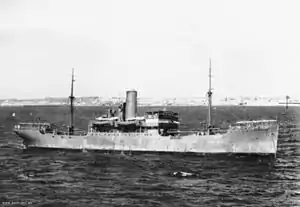HMAS Poyang
HMAS Poyang (FY-20) was a 2,873-ton former steamer that was commissioned into the Royal Australian Navy (RAN) during the Second World War.[2] It was one of a group of vessels known as the "China Fleet", which were acquired by the RAN in similar circumstances.
 Cargo steamer Poyang prior to being requisitioned by the Royal Australian Navy in 1942. | |
| History | |
|---|---|
| Owner: | China Steam Navigation Company |
| Builder: | Taikoo Dockyard Engineering Company, Hong Kong |
| Launched: | 1920 |
| Commissioned: | 6 December 1943 |
| Decommissioned: | 6 March 1946 |
| Identification: | IMO number: 5401388 |
| Fate: | Broken up in 1970 |
| General characteristics | |
| Class and type: | Steamer |
| Length: | 299.7 ft (91.3 m)[1] |
| Beam: | 44.2 ft (13.5 m) |
| Draught: | 23.1 ft (7.0 m) |
| Speed: | 13 knots (24 km/h; 15 mph) |
Built in 1941 for the China Steam Navigation Company, Poyang was acquired by the RAN in 1942, and commissioned into naval service at the end of 1943. Poyang operated with the RAN until 1946, when she was decommissioned and returned to her owners. The ship changed hands several times between 1963 and 1965, and operated under the names Bali Steer and Rosalina. The vessel was scrapped in 1970.
Design and construction
Built by the Taikoo Dockyard Engineering Company, Hong Kong in 1941 for the China Steam Navigation Company.[3][4]
Operational history
Poyang was requisitioned by the Royal Australian Navy in May 1942.[2] She plied the east coast of Australia and also was in Nouméa and Milne Bay during 1942.
She was commissioned into the Royal Australian Navy as HMAS Poyang on 6 December 1943 and served in New Guinea waters in 1944. Sailed as part of the supply force for the Leyte campaign, and was attached to the supply force for the military landings at Lingayen Gulf, however Poyang was not present at the landing. She then served in Australian waters until early 1945, where she served in New Guinea and Morotai areas.
Poyang was part of the landing on 22 September 1945 of the Australian 33rd Brigade on Ambon for the surrender of Imperial Japanese forces on the island.[2] The vessel returned to Australia, after serving in Solomon Islands area, on 12 January 1946 and was paid off on 6 March and later handed back to her owners.
She was sold in February 1963 to Power Navigation, Hong Kong, then resold to Steering Line, Hong Kong and renamed Bali Steer.[2] She was transferred to Steering Line Company, Liberia in May 1964, and delivered to Cia Nav. Viento del Sur, Singapore in June 1965 and renamed Rosalina.
Fate
Rosalina arrived at Singapore on 9 April 1970 and was broken up by National Shipbreakers in July 1970.[2]
Notes
- "Lloyd's Register 1943-44" (PDF). plimsollshipdata. Retrieved 9 September 2011.
- "HMAS Poyang". Allied Chinese Ships WWII. Allied Chinese Ships Association. Archived from the original on 29 October 2003. Retrieved 9 September 2011.
- "China Navigation Company". The Ships List. Archived from the original on 2 October 2011. Retrieved 9 September 2011.
- The archives of John Swire & Sons Ltd (including the papers of the Taikoo Dockyard and the China Navigation Company Ltd) are held at the School of Oriental and African Studies, London, http://www.soas.ac.uk/library/archives/